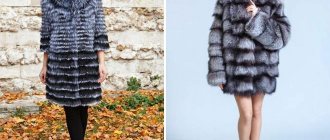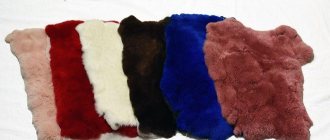The red fox is the most famous and sought-after fur-bearing animal of the fox family. The species classification of the fox genus can be viewed here: Classification of foxes (part one). Along with the dominant fiery red color of this animal, there are also a lot of non-standard shades, both natural and artificially obtained through crossing. In total, there are more than fifty colors of red fox, but the most popular are the subspecies of black-brown and silver-black foxes. Let's look at the most famous and popular of them.
Black and brown fox
Black and brown fox fur is considered one of the most sought after and expensive. This animal was first discovered in North America and is a natural mutation of the red fox color gene. In any North American red fox population, up to 8% of the population is black and brown. In this case, several options can be distinguished: completely black with a white tip of the tail, gray with a brownish tint, gray with a silver tint, gray with a bluish tint, black with ashen sides and belly. Regardless of color, the tip of the tail remains white.
Black and brown fox
Fox fur colors
There are several varieties of fox fur color.
- 1. Silver foxes. Their fur has a silvery-black tint. This type of fur has always been valued by clothing manufacturers and is widely used by most designers. The silver fox's hair is colored in three colors - a dark gray base, a white middle and black ends. The more pronounced the white color of the flesh, the higher the cost of the material. The main feature of silver fox fur is that it can be easily dyed and processed. The result of dyeing is a bright and smooth color transition that decorates any fur product.
- 2. Fires. This type of fur is the most rare and expensive. The bright red color is of great value for making fur coats. The hair of moths is evenly colored; at the ends you can see a small gray fluff. Sometimes there is a white tint on the guard hair, which creates a moire effect. This color transition looks very beautiful and rich.
- 3. Crosses. When crossing silver foxes and moths, a different color appears - the cross. The skins have a dark red tint, and black hair is placed in the middle in the shape of a cross. This type of fox fur color is very common in the modern fashion industry.
- 4. Platinum. The guard hairs have a white tint, which gradually turns into gray. Towards the middle of the back the coat becomes darker in color.
Active selection of foxes does not stop, so at auctions and fashion shows you can see new colors of fox skins. Due to its texture and aesthetic qualities, fox fur is constantly used by famous clothing designers, and fur coats made from this material become part of the wardrobe of many famous people.
Silver-black fox
The silver-black fox is the product of crossing the common red fox and mutated forms of South American individuals. The result of this mutation was the black color of the guard hairs of the fox's fur. This subspecies differs from the black-brown fox in that, in principle, it is not possible for it to have red guard hairs, while the black-brown fox can have red fur color on the inside of the ears, shoulder blades, hips and sides. The black color of the guard hair and the lighter underfur give the total silver-black color of the skin, the intensity of which can vary from almost silver to almost black. The tip of the tail remains white in any case. It grows wild in Alaska and the entire north of the North American continent. The silver-black fox has the longest fur and also serves as the parent form for the artificial breeding of new subspecies with original coat colors.
Silver-black fox
Red fox fur
Wild red fox
The fox Vulpes is a mammal of the canine family and the wolf subfamily, distributed throughout the world. There are several dozen species of foxes, but only 11 species are directly related to the fox species. All foxes whose fur is used for production are divided into wild and farmed.
Wild foxes are the European red foxes Vulpes vulpes, the Canadian gray foxes and the Argentine gray foxes. The fur of the gray Canadian and Argentine wild fox "Greyfox" gracefully combines gray, black, red and silver colors.
The common fox is distributed very widely: throughout Europe, North Africa (Egypt, Algeria, Morocco, northern Tunisia), most of Asia (up to northern India, southern China and Indochina), in North America from the Arctic zone to the northern coast of the Gulf of Mexico . The fox was acclimatized in Australia and spread throughout the continent, with the exception of some northern regions with a humid subequatorial climate.
The fox is a medium-sized animal with large, pointed ears and a long, bushy tail. The length of the fox is 60-90 cm, and its tail is 40-60 cm. In nature, the most common red foxes and crosses have a dark vertical stripe along the ridge and a horizontal stripe in the area of the shoulder blades. Steppe and desert foxes - caraganas - have a yellowish-gray or yellow color; in the Far East, the color is almost red; among Caucasians it is gray. Also found are fireweed and gray lion.
According to the type of habitat, foxes are divided into: - forest - with the most lush and soft fur;
- steppe - grayish tint;
- southern - with a coarse awn and sparse underfur.
It is characterized by a red or ginger color of various shades, with tints from fiery red to almost gray. The color variability of wild foxes largely depends on the habitat. The chest is white or light yellow, the abdomen is white, red or with a black spot on a red background. The ears and ends of the paws are black. The tip of the tail is usually white or gray due to gray underfur or individual pigmented hairs. Individual black hairs are scattered along the tail, and often throughout the body.
The underfur on the entire body is gray or brown in different shades; the brighter the main color, the darker the underfur. Depending on the type of fox, the thickness and length of the fur and its softness differ. There is long and fluffy fur, as well as coarse fur of medium length. The wild fox has soft hair, a short, thin and soft spine, and a thin inner core. A light (yellow) wild fox with a lot of silver hair is also called “gray soul” or “gray soul”.
The wild red fox can be Russian or Canadian. Differences: the Russian is more “cotton”, it is lighter and more “grey-souled”, the Canadian has a higher and stiffer spine, on average, it is darker and brighter. There are no miracles in terms of prices - the principle remains the same, which is why Canadian is more expensive than Russian. Any wild fox has problems with commercial fur: rapid abrasion of the fur, a greater number of defects in the pile and problematic dry cleaning. In the Russian fox, this can be aggravated by artisanal dressing. Assuming similar quality and size, the value line looks like this, from $30 to $1000:
— Russian “sivodushka”;
— Russian/Canadian yellow;
— Russian/Canadian “fire”;
— Canadian dark “firefox”/light farm foxes “gold” and “golden type”, red farm fox/Vyatkinskaya;
— exclusive – especially bright, especially dark and especially large Scandinavian farm foxes.
For any fox fur, the rule is: the more red the color, the darker it is and the less light yellow and gray, the more valuable the skin; color is a more important factor than size. In the same skins of wild and farmed foxes, there will be differences in the structure of the pile and flesh. Since the color and size of a farm fox “begins” where the best wild varieties already “end”, on average a farm fox will be 30% more expensive. A golden farm fox is on average 50% more expensive than a silver fox.
Farm breeding of foxes
All farm foxes can be divided into four types:
1. Russians - characterized by a low, soft spine, the structure of the pile is similar to wild fox fur, the skins are medium in size.
2. North American - the awn is stiffer and longer, the awn is high, the underfur is larger, the size of the skin is larger, and therefore the pile is higher and the flesh is thicker.
3. Norwegian - the awn is tall and beautiful, thick pile, high dense down, large skin.
4. Finnish - have the largest guard hair, reminiscent in appearance of exotic feathers, have thick pile, and a large skin size.
Most red foxes are characterized by the presence of zonally colored hair (agouti) located along the back and sides. It is not uncommon for red foxes to have gray hair—pure white hair scattered throughout the body and white patches on the chest, belly, and paws. Red foxes with a pronounced red, or fiery, tint - moths - are the most beautiful, they are “cotton-like”, with a soft spine. Currently, such foxes are bred in the Vyatka animal farm in the Kirov region, called “Vyatkinskaya”.
Foxes, like other animals, have albinos. They have pure white fur, depigmented tip of the nose and claws, light blue eyes with a reddish tint.
When a silver-black fox is crossed with a red fox, the offspring produced are gray foxes and bastards. Gray foxes are characterized by a significantly greater development of black pigment; bastards are similar in color to red foxes, but always have black spots on both sides of the upper lip - “whiskers”.
Several mutations have been registered in silver-black foxes; of the mutant forms, platinum, white-faced and snow foxes are bred in small numbers in our fur farms.
Platinum foxes are much lighter than silver-black ones and have a characteristic white spotting: a white stripe runs from the tip of the nose between the eyes and ears to the back of the head, where it merges with a wide white collar. On the chest, the collar connects to the white belly. The tips of the paws are white, but they usually have isolated pigmented spots. These foxes are characterized by the presence of platinum hair. When pure platinum foxes are bred, the fertility of females decreases by 25%, which is associated with the death of embryos homozygous for the gene.
White-faced foxes have the same pattern as platinum foxes, but the intensity of their base coloration is similar to that of the silver-black fox.
Snow foxes are white in color, sometimes with a cream tint. The ears remain black, as do individual spots on the face, back, and paws. In addition to the listed color types, small numbers of pearl, brown, beige and other foxes are bred abroad.
Fox farming is poorly developed at this stage. In Russia and America, they are engaged in the selection of new colors of foxes in individual farms. Thanks to the selection work carried out on animal farms, it was possible to develop a wide variety of colors, and modern methods of dressing and dyeing can give it a wide variety of colors and shades. On fur farms, the bulk of foxes bred are silver-black, while fireflies are bright red and platinum. Much more foxes are bred in Scandinavia, so Finland and Norway are the world market leaders in raising and selling new fox breeds.
European farm foxes have a thick pile and very high guard hair, which is highly valued by designers. Farmed foxes are produced at various European factories and are usually purchased at European fur auctions Finnish Furs and Kopenhagen Furs. About 2 million skins are sold there per year. These auctions are held in February, April, May, September, December. The February auctions determine fur prices for the season. Sometimes new skins of unusual colors appear at auctions in quantities of only a few dozen. Entire wars break out between fashion houses over such fur. The fur of farm foxes comes in a variety of colors. Foxes have been bred with very exotic shades: Arctic Marble Fox, Golden Island Fox, Smokey Fox, Fire Gold Fox.
The charm of fox fur
Fox fur is a long-haired fur. He has a very long pile and a thick underfur. The hair is thick, soft, lush, silky, long, warm, with high heat-protective properties. The length of the pile is up to 8 cm. The length of the skin is 50-90 cm. The tail is about 50 cm. Wear resistance is 50%. The color is red, in various shades from pale yellow to dark red. Based on the color of their hair, they can distinguish between the common fox, cross fox, gray fox, black-brown, silver-black, platinum, snow - the hair is white, there are black spots on the legs and muzzle, and there is a black belt on the ridge.
Fox fur is charm, uniqueness, style. Bright, sensual, long-haired, it has always attracted the attention of people trying to stand out from the crowd; the fox's fur is soft and quite delicate. The product is made from fox fur, warm and ideally protects from bad weather and frost. The wear life of the products is up to 8 years. Fox fur has been used in fur clothing since ancient times. Long-haired fox fur is suitable for those who value comfort and warmth. Lush fur can enhance energy and give its owners a touch of sensuality, which is why fox fur is mainly used in luxurious, evening models. Fox skins are used for collars, boas, capes, hats and for trim. Fur coats are made from paws, and hats are made from fox tails.
Fox fur in 20th century Hollywood
At the end of the 19th century, St. Petersburg newspapers wrote: “The fox delights with its many shades. Even after death, she is capable of taking on all sorts of forms in order to help the coquetry of women who are fond of tricks and tricks like this predator.”
The rise of Hollywood cinema played an important role in the history of fox fur. The president of the Paramount Pictures film company was a furrier and did a lot to ensure that luxurious, lush fox fur took its rightful place on the silver screen. In 1932, Marlene Dietrich appeared on screen for the first time wearing a fox fur coat; before that, fox fur was used only for decoration. In the 30s of the 20th century, it was fashionable to wear several fox skins, fastened together with paws and faces made of papier-mâché. In the 40s, pin-up girls posed in fox fur coats, and in the 50s, Marilyn Monroe and Elizabeth Taylor. In the 60s, Raso Rabanne designers introduced coats made of dyed fur with metal inlays. In 1971, Yves Saint Laurent presented a collection dedicated to Carmen Miranda, which included fox fur coats painted in bright, unconventional colors, which shocked the public. This collection shocked the older generation and went down in fashion history as scandalous. In the 90s, people again remembered the red fox and its natural attractiveness. Much later, dyed furs became more popular and widespread. The leader in the production of dyed fur products is Fendi, whose designers are constantly experimenting. Currently, fur fashion is democratic, the main thing is that it is warm and cozy. And long-haired fox products for frosty weather!
Folk beliefs about the fox
The fox is the most important object of hunting and cage breeding. Despite being persecuted by humans, this cunning and intelligent beast is still common even in agricultural landscapes. The intelligence and resourcefulness of foxes have long attracted human attention. In the folklore of most peoples, the fox serves as the personification of cunning and female cunning. In the East, there is a widespread belief that foxes are capable of turning into charming women, seductive destroyers of men. Similar ideas about werefoxes existed in Europe. In Japanese mythology, there are kitsune werefoxes who can take on human form. They have enormous knowledge and master magic. Kitsune later became popular in literature, cinema and video games. Spirits similar to kitsune also appear in Chinese and Korean myths. In Mesopotamian mythology, the fox is a sacred animal. She serves the goddess Ki as a messenger. In Finland, the fox is a symbol of cunning, but not evil.
Since ancient times, people have personified animals, and many signs and legends have developed. The fox will cross the road - fortunately, - the Hutsuls believed. In Russian fairy tales, the fox often plays the role of a mourner, midwife and wise adviser. In some Buryat and Evenki clans it was forbidden to shoot foxes. The fox was revered in China. In her honor, idols were erected and sacrifices were made. The fox could cure the disease. At 1000 years old, the fox turned into a “heavenly fox” who knew all the secrets of nature.










